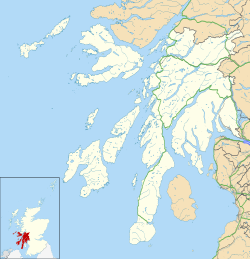Kilmelford
| |
|---|---|
 Looking to Kilmelford from Ceann Mòr (119 m) | |
Location within Argyll and Bute | |
| OS grid reference | NM845125 |
| Council area | |
| Lieutenancy area |
|
| Country | Scotland |
| Sovereign state | United Kingdom |
| Post town | OBAN |
| Postcode district | PA34 |
| Dialling code | 01852 |
| Police | Scotland |
| Fire | Scottish |
| Ambulance | Scottish |
| UK Parliament | |
| Scottish Parliament | |
Kilmelford (Scottish Gaelic : Cill Mheallaird) is a village in Argyll and Bute, Scotland.
Contents
It is situated near the head of the west coast sea loch, Loch Melfort, on the A816 Lochgilphead to Oban road about 15 miles (24 km) south of Oban. [1]
